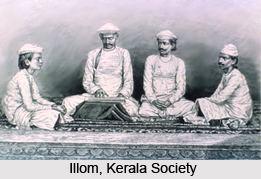 Illom is the name of the joint family system of the Namboodiri Brahmins of Kerala. The medieval Kerala society was not only determined by caste, but also by parallel systems of patrilineal and matrilineal inheritance. The matrilineal system, which is also known as Marumakkathayam, was believably the most widespread; it was followed by the Nayars, Ambalavasis, Kshatriyas and Moplahs or Muslims of Malayali race, and partially by the Ezhavas and the outcaste groups. In the Hindu community, the Brahmins and the Kamalla castes of craftsmen were the main groups who were abided by Makkathayam or patrilineal inheritance. However, the Moslems of Arab descent, Christians and Jews also inherited patrilineally but differed from the Hindus by living in nuclear families.
Illom is the name of the joint family system of the Namboodiri Brahmins of Kerala. The medieval Kerala society was not only determined by caste, but also by parallel systems of patrilineal and matrilineal inheritance. The matrilineal system, which is also known as Marumakkathayam, was believably the most widespread; it was followed by the Nayars, Ambalavasis, Kshatriyas and Moplahs or Muslims of Malayali race, and partially by the Ezhavas and the outcaste groups. In the Hindu community, the Brahmins and the Kamalla castes of craftsmen were the main groups who were abided by Makkathayam or patrilineal inheritance. However, the Moslems of Arab descent, Christians and Jews also inherited patrilineally but differed from the Hindus by living in nuclear families.
The patrilineal joint family of the Nambudiri Brahmins was called the Illom, and had its own peculiarities. Like the Nayars, the Namboodiris were anxious to safeguard their properties from division, but instead of instituting a democratic family council as the means of preventing unjustifiable fragmentation, they relied on a system of primogeniture which seems like a parody of the Freudian primal horde. Only the eldest male member of the Illom was allowed to marry women of his own caste; he was allowed polygamy to the extent of four wives. Nevertheless there were large numbers of young Nambudiri women forced to live a life of perpetual spinsterhood within the seclusion of the household and, of course, many younger sons and brothers in every Illom who did not expend their physical energies on either farming or warfare.
To fulfil the abundant sexual needs of these superfluous Namboodiri males, the peculiar custom of Sambandham was evolved, which was a modification of the pollution laws and allowed sexual contact between Namboodiri men and women of the Ambalavasi caste or of the higher sub-castes among the Nayars. Very often polyandry took the form of a woman being shared by a visiting Namboodiri and a Nayar husband. The proud and warlike Nayars accepted and even have felt honoured by an arrangement which in almost any other society would seem humiliating, is a sign of the degree to which, by the middle ages, the Brahmins had established their supremacy in the state of Kerala.
The younger sons of Illom used to visit the house of their life partners after nightfall and the children resulted from their union became members of the tarawads of the mother. The Nayars took immense pride to give their daughters to the Namboodiri Brahmins even if the marital bond was very loose. The wives of the young members of the Brahmin family were not treated well in the Brahmin Illom. The Namboodiri husband did not possess any responsibility towards wife and her children of the Nayar community, and all their responsibility was taken by the Nayar Tarawads. The Namboodiri Illom comprises of a man along with his wife or wives and his children and young brothers. However, the Illom also comprises of his eldest son`s children and his own parents.
The continuation and perpetuity of Illom property among the Namboodiris are eased with the help of the custom which gives authority to the eldest son to marry a girl from his caste and the younger sons usually don`t marry Namboodiri women. In case, the elder son is unable to produce children to the family, then the next senior son of the family marries and helps in the continuation of the family. The right of partition of property was checked, and the juniors in the family have the right to maintenance. While the eldest son of the Illom possesses absolute power over the property of the family, he does not have the right to gift or sale the same without getting the permission of other members. Even the Illom`s female members are required to give their consent in case they need to alienate it. The system of dowry was well-associated with the Namboodiri marriage and the amount of dowry was much high, which was paid mainly by the Illom money.



















